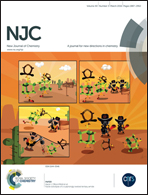A biopolymer gel-decorated cobalt molybdate nanowafer: effective graft polymer cross-linked with an organic acid for better energy storage†
Abstract
Nanoflake-like α-CoMoO4 was prepared with the aid of a cationic surfactant, cetyltrimethylammonium bromide (CTAB), as an electrode material for supercapacitors by scalable solution combustion synthesis (SCS). The specific capacitance of the fabricated hybrid device (CoMoO4/CTAB vs. activated carbon (AC)) was 39 F g−1, a marginal increase compared to that of the as-prepared (parent) CoMoO4 (24 F g−1). To achieve better energy storage, modification was carried out on CoMoO4 by grafting chitosan onto it in the presence of a weak acetic acid (AA) or citric acid (CA) crosslinking agent. The biopolymer chitosan is cross-linked when using CA as a cross-linker, while in the case of acetic acid, grafting of chitosan/AA does not occur. The improved properties of CTAB- and polymer-modified CoMoO4 were evaluated using physical and electrochemical methods and compared with the as-prepared (parent) compound. The polymer-modified composite exhibited a maximum specific capacitance of 71 F g−1 at 2 mA cm−2 with a capacity retention of 81% after 2000 cycles, about twofold higher than that of the CTAB-modified electrode. The influence of surfactant and chitosan concentrations on the specific capacitance is also established. A solid state capacitor was fabricated using CoMoO4vs. AC, with chitosan as the gel separator. High resolution transmission electron microscopy (HR-TEM) and field emission scanning electron microscopy (FE-SEM) images support the cross-linking strategy and nanowafer-like morphology with a honeycomb arrangement.


 Please wait while we load your content...
Please wait while we load your content...